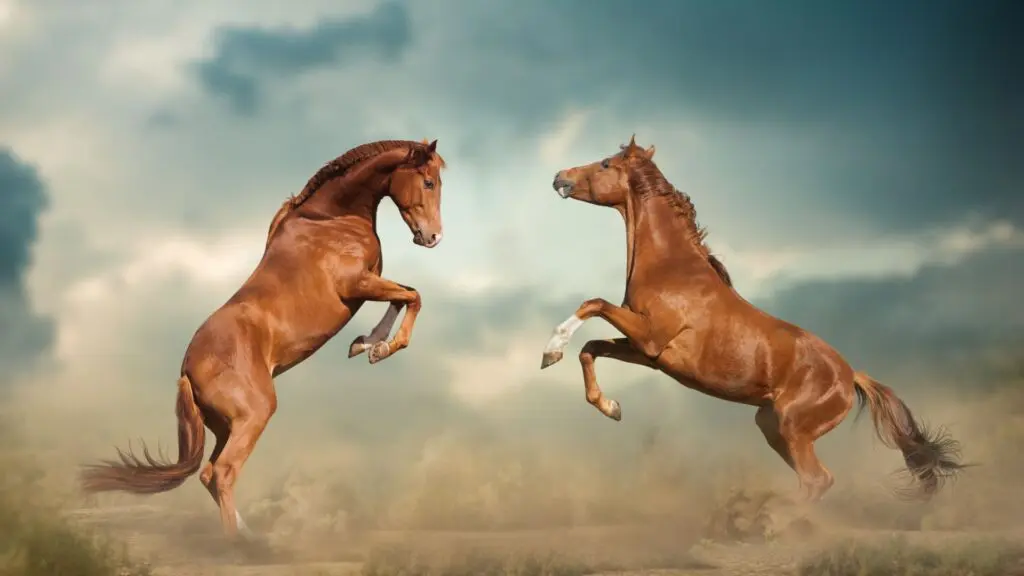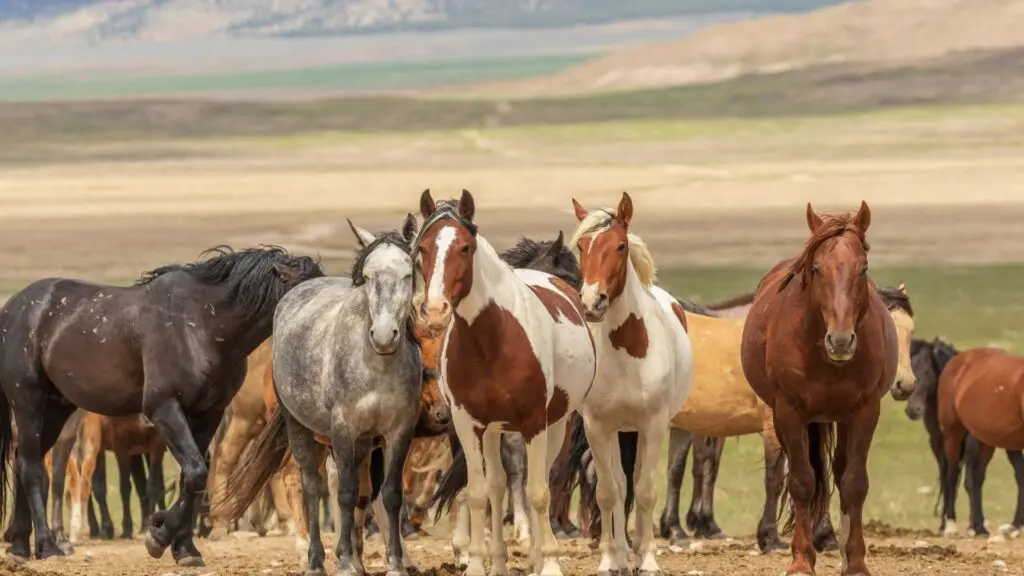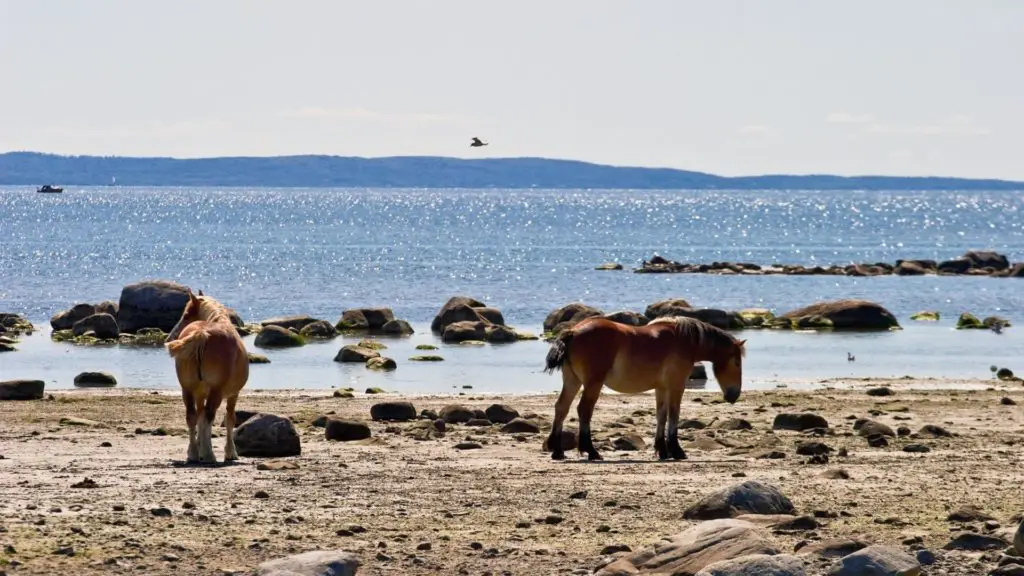Last updated: February 16, 2023
We are taking children to visit wild horses held by the Bureau of Land Management. The children are extremely comfortable around horses, but I’m concerned these wild horses may be dangerous.
Wild horses are prey animals and can be dangerous, especially in confined and unfamiliar surroundings. Since they aren’t accustomed to humans, they perceive us as a threat. When horses are threatened and have no place to retreat, they will attack.
Viewing wild horses roaming the plains is a fantastic site. However, these animals aren’t pets and should be respected and treated differently than domesticated animals.
Will wild horses attack you?
Before arriving at the facility, we instructed the children that they shouldn’t approach any mustangs. However, I wondered if they would attack unprovoked.

Wild horses can attack humans, but they rarely do. They are prey animals, and their first instinct is to flee danger. However, stallions and horses separated from their herd can be aggressive.
Many people want to approach wild horses; however, it is best to observe them from a distance for your safety and their best interest. Horses are large, powerful animals that have the potential to cause serious injuries to humans.
Horses seriously injure people.
Below is an excellent YouTube video about a mare that has attacked its owners and bitten them multiple times. Clinton Anderson, a well-respected horse trainer, explains why horses attack, and he works with these animals to prevent their bad behavior.
A horse’s rear leg kicks are powerful enough to break bones and kill animals and humans. Many people have died after sustaining a horse kick. Avoid standing directly behind a horse; the safest location to stand is near a horse’s shoulder.
Horses have powerful jaws and can inflict severe damage with a bite. Horses that don’t have the option of fleeing or feeling threatened will bite and stomp an opponent with their front legs.
When stallions fight for dominance of a herd, they rear up on their hind legs, deliver blows with their front legs, and try to bite each other. When humans approach horses, their instinct is to flee but left without an option, they attack and deliver devastating punishment.

What do you do if you see a wild horse?
If you’re lucky enough to see wild horses on a hike or camping trip, give them space. The general rule is not to get within 50 feet of wild horses. However, most parks and the Bureau of Land Management (BLM) have separate regulations in place.
So if you anticipate contact with wild horses, confirm with the park rangers or the BLM the requirement for the location you plan to visit. And although the general rule is to give the animals a 50-foot cushion, many parks don’t want you to get closer than 100 feet.
Be respectful of their habitat, move off their path, and never walk through a herd. Remember not to leave any trash and never feed wild horses. The goal is to be as unintrusive as possible.
If you are in a car and want to observe the wild animals, stay on the designated paths, and shut off your engine.
Why are wild horses a problem?
Wild horses are reproducing at a high rate and stressing the natural environment. The number of animals is growing at a rate of 20 percent per year. And their grazing is already wiping out native plants and threatening other wildlife.
Overpopulation leads to the depletion of grazing sources, likely leading to starvation and death for horses and other wildlife. It also wreaks havoc on the environment through erosion and the destruction of native plants.
If the number of wild horses continues to increase at its current rate, the ecosystem could be devastated. To provide some context, here are the population estimates from the United States Department of Interior’s 2019 report on wild horses and burros:
- Total wild equines on public rangeland-88,000
- Wild horses account for approximately 72,000 of the animals
- Burros are estimated at over 16,000
- Besides the horses and burros free-ranging, the BLM also houses close to 50,000 animals at government holding facilities.
- The Government estimates that the land has water and grazing resources for approximately 26,500 animals.
- Wild horses overpopulate the available resources by more than three times.
In this same study, the BLM estimated that each wild horse kept in captivity costs $50,000 per animal over its lifetime. They calculated that it would cost one billion dollars to care for and treat the animals in the current population.
What does the BLM do with wild horses?
The Bureau of Land Management (BLM) is a part of the U.S. federal government. They are tasked with managing federal public lands, which includes, among other things, the responsibility to oversee the wild horse and burro program.
The Bureau of Land Management has a demanding job requiring them to watch over the wild horse population on 26 million acres of public land. This includes scheduled vet checks, and even though most wild horses don’t need to wear horseshoes, they still may need other farrier care.
But not only do they have to manage the horse population, but they must do this under strict congressional constraints of THE WILD FREE-ROAMING HORSES AND BURROS ACT OF 1971
Population control
To protect the land and the animals, the BLM must reduce the number of horses free-roaming on public land. To facilitate this, they employ a two-prong approach; the first is the removal of the animals, and the second is controlling their ability to reproduce.
The BLM removes horses with the goal of placing them in a good and safe home. They typically remove horses from herds where the population is causing the most impact. BLM’s goal is the removal and placement of 9,000 horses and burros.
One program that has gained in popularity is the Training Incentive Program for Mustangs (TIPS). This program removes mustangs from public land and sends them through a training program established and managed by the Mustang Heritage Foundation.
In conjunction with the removal program, the BLM is also actively taking steps to suppress the rate of births of wild horses. However, they currently have no long-term answer.

The anti-fertility vaccine is only good for twelve months and requires a booster within 15-30 days. Two problems arise with this program. First, the follow-up shot is only possible if the herd is tracked, and even if the horse receives the booster, the drug’s usefulness wears off after one year.
Annual treatment seems impractical because of the vast expanse that wild horses travel. The BLM works with universities and private companies to develop more efficient drug and permanent sterilization methods.
Facts about wild horses
They are believed to be descendants of the horses brought over by the conquistadors in the 16th century. The horses escaped or were released into the wild because their owners could no longer care for them.
Many of the horses were captured by the Native Americans and used for transportation. The remainder lived in the wild, where the strong survived and developed into the wild mustangs we know today.
Wild horse’s physical characteristics
Not all wild horses are the same, but generally, they’ve evolved into hardy animals with strong bones and tough feet. Most live in small herds with one dominant stallion.
Mustangs are generally smaller, only 14 to 15 hands tall, and are found in various colors, but the dominant colors are bay and sorrel. Wild horses have a long lifespan; some live to be 40 years old.
Wild horses are not endangered.
The population of wild horses is exploding; currently, over 88,000 mustangs are roaming public land, and at the rate they are reproducing, they could double their number in 4 to 5 years.
Wild horses are protected.
Congress passed legislation in 1971 to protect wild horses and burros. The act is called The Wild Free-Roaming Horses and Burros Act of 1971. Congress recognized that free-roaming horses and burros have a symbolic and historical value that warrants preservation.
The act provides wild horses protection against capture, branding, harassment, and death and recognizes the animals as an integral part of the natural system.
Do wild horses have a positive impact?
Wild horses are blamed for much of the damage to public land. Their overpopulation and subsequent damage are well documented. However, they also contribute to the health of the environment.
Horses’ manure spreads plant seeds and enriches the soil. Large herds of horses can reduce the amount of dry forage, which is fuel for fires. Horses are also a food source for natural predators on the land.
Wild horses attract tourists in areas where they are readily accessible. Tourism typically brings economic benefits to the local communities. Wild horses also give us a peek into the past.
Below is a YouTube video on the wild mustangs of Nevada.
Related articles:
- Are Horses Native to North America? The Fossils Tell a Story
- Are Appaloosa Horses Rare? Are They Good Kids Horses?
- What is the Best Horse Breed? (Top 3 Breeds By Activity)
- 10 Differences Between Ponies and Horses: Size, Breeds …
Meet Miles Henry
An avid equestrian and seasoned racehorse owner, Miles Henry brings his extensive experience to the equine world, proudly associating with the AQHA, The Jockey Club, and various other equine organizations. Beyond the racetrack, Miles is an accomplished author, having published various books about horses, and is a recognized authority in the field, with his work cited in multiple publications.
🔗 Connect with Miles:
Twitter
Facebook
YouTube: Check out race highlights, horse care tips, and more!

